
A few days ago I had the pleasure to meet the Italian sculptor Andrea Bianco. He is a sightless artist that works with different materials, ranging from marble and wood to clay and bronze. He welcomed me to his house, where I had the opportunity to personally interview him. I was able to enjoy a private view of some of his sculptures, accompanied by descriptions from the artist himself. Andrea Bianco let me even touch one of his first sculptures, a portrait of a man in limewood; an experience that goes beyond the limits of the visual towards the rediscovery of the sense of touch.
In 2017 he won the International prize Michelangelo Buonarroti at Seravezza for his sculpture Camelia. In 2018 he did a personal exhibition at the showroom Poggenpohl in Milan. Omaggio alla donna (Homage to the Woman) was the title of a series of his personal exhibitions that took place in different cities in Italy throughout the year 2019, including Forte dei Marmi (during the Italian national week against violence on women), Palazzo Ducale in the city of Massa, Palazzo Grassi in Chioggia, the medieval castle Maschio Angioino in Naples and the Academy of the Arts of Drawing in Florence (which is the most ancient academy, built by Vasari).
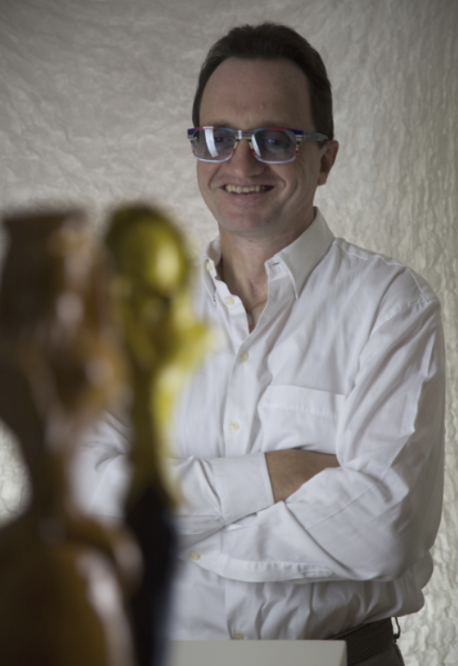
Andrea Bianco
Ph: Andrea Bianco, Oltre l’apparenza (Beyond appearance) catalogue
Portrait of a man, Limewood
Ph: Belen De Bacco
- How would you define your style? Is it figurative art tending towards abstractism?
It is a question that I asked myself many times because I didn’t even know how to define it myself. I would say that your definition could in some way be correct but it once occurred that a sculptor came to one of my exhibitions and described my art as metaphysical. I agree also with this definition because metaphysical means something that goes beyond the senses, therefore I see my art both in the definition that you have previously stated, figurative art tending towards abstraction – even though it is not completely figurative – but also metaphysical because with my figures I sometimes want to communicate a message that goes beyond the figures themselves.
2. What pushed you to choose sculpture as an expressive tool?
Sculpture is the art form that adapts best to a sightless person. I do not want to define myself as a sightless sculptor, instead, I only prefer to use the word sculptor because by adding ‘sightless’ in the definition it would always function as a justification for creating an artwork that results poorly made. Instead, I opt for the simple label of sculptor. If I think that one of my artworks was not done well, I am conscious of the fact that I have to put even more effort into it but my constant aim is to reach a result that is equivalent or even better than the one created by an artist with the sense of vision.
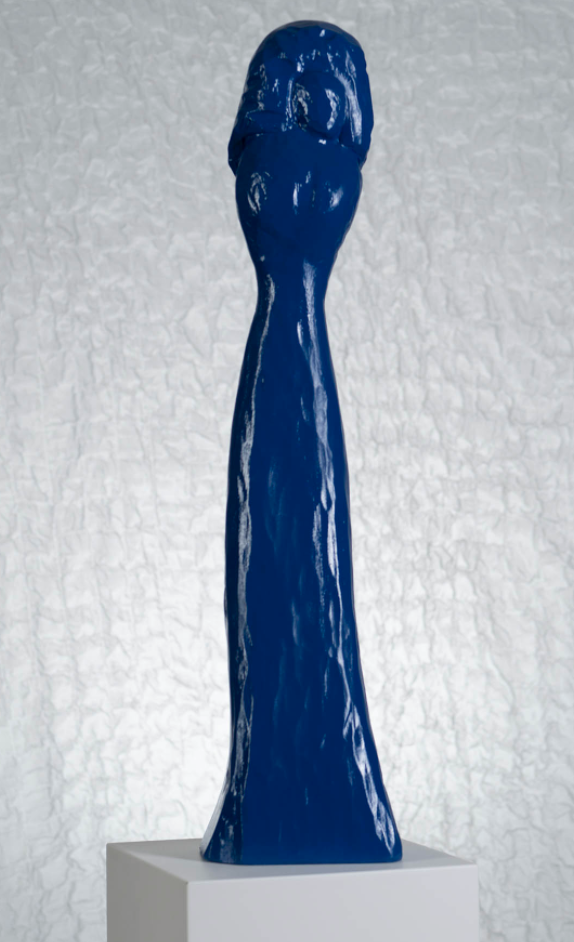
Olivia, Pinus cembra treated with acrylic colour
Ph: Andrea Bianco, Oltre l’apparenza (Beyond appearance) catalogue
Giuditta, Fired clay
Ph: Andrea Bianco, Oltre l’apparenza (Beyond appearance) catalogue
3. It is interesting to notice that although we are talking about art, something that is normally created through observation, you are able to develop it through the sense of touch. What are the factors that become dominant while being a sightless sculptor?
We all have the sense of touch but it is often forgotten. It is a fundamental sense because it is the first way in which we discover the world; when children start exploring the objects around them, they want to touch everything or put these in their mouths, representing another form in which the sense of touch emerges in an early stage of life. Children constantly hear that this is rude, that it should not be done, therefore the sense of touch is lost and at the end, we forget about it. Because the senses are five, I believe that we should rediscover them, especially the sense of touch. We all have it, the main difference is that I strongly rely on it for necessity. I try to make any sculptor – not only sightless people – understand that the sense of touch is important because the sensations that we are able to feel through the touch cannot be obtained through vision. 85% of the stimulus arrives to the brain through the sense of vision while the rest is represented by all the other senses. Because I cannot rely on such an important sense anymore, I try to integrate touch and hearing. The latter helps me when I am carving because depending on how I use the chisel to carve the material it makes a different sound. If I am working with wood, the sound changes according to the part of the wood I am working with i.e. if there is a node, the sound will be different from a smooth surface.
4. “Different materials, one theme.” You mainly work with materials such as marble, wood, clay and bronze. Because you focus on the concept of the artwork through the sense of touch, do you think that this would make you more sensitive towards the property of each material? How does the concept of the female figure change according to different materials?
I think that each artist finds the material that works best for him, this means that a specific material is able to express at its best the idea of the artist. I personally prefer wood because I believe that it is a school; I give the shape to it but the wood educates me to have patience and to predict the result of each move I do with the chisel. Regarding the female figure – which is a recurrent subject in my artistic production – some people made me notice that the female figures I create in wood and marble are more curved and robust than the ones I create in clay but there isn’t a specific reason for this. The elongated figures highlight the inner rather than the external beauty of a woman because I believe that often women are trivialised. Instinct is what guides me and maybe also the material itself. The fact that I cannot draw a draft – a basic step for artists – gives me more freedom during the creative process because I can change my plans also while I am in the middle of the process of carving. I believe that thanks to this freedom my artworks appear as more spontaneous.
5. Did you think about a career in the art sector before the car accident?
The artistic spirit is in the nature of the person, either you have it or you don’t, it lies in the DNA. This spirit does not only mean considering art as an expressive tool, it is rather a lifestyle. I definitely thought about working in the art sector but in Bolzano [the Italian city in which Andrea Bianco was born and still lives today] there was no art school at that time, therefore, I had to put my dream aside. I also believe that today art and business sometimes are confused but in my case, I use art as an expressive tool, a way of communication. I tend to lean on the original aim of art, highlighting the enrichment on an emotional level.
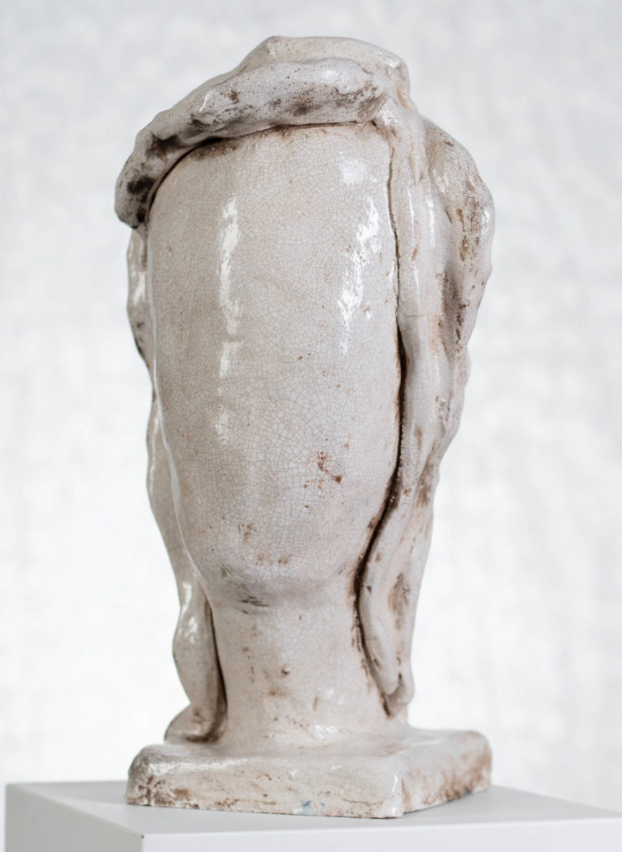
Berenice, Fired clay treated with Raku technique
Ph: Andrea Bianco, Oltre l’apparenza (Beyond appearance) catalogue
Susanna, Pinus cembra
Ph: Andrea Bianco, Oltre l’apparenza (Beyond appearance) catalogue
6. The curator Eva von Ingram Harpf once commented “Andrea Bianco’s sculptures highlight the female body with precise characteristics, often without any determined features that leave to the spectator the possibility of discovering inner beauty.” I was moved by the emphasis on the precision of the female features. How are you able to conceive them?
I create a mental image in order to conceive the sculpture. I have visual memory because I had the sense of vision until I was 20 years old. Even though I remember figures, shapes and colours, I want to focus on the inner beauty of the woman. Sometimes the female figure in my artworks is even impoverished on the exterior i.e. they are devoid of faces, arms and sometimes even the curves typical of its figure. This impoverishment has the aim of enriching its inner dimension. I believe that women have been trivialised and exploited throughout history but especially today, a time in which I think it is fundamental to give importance to the inner beauty of women. They have feelings and a special sensitivity that men do not possess. I think that first of all, women should understand this and get to know their potential and then men should push themselves into gaining this understanding. This is the intent of my art.
7. “Toccare per credere” (“Touch to Believe”) is the title of an exhibition you did at the Free University of Bolzano from the 21st to the 25th of November 2016. It is interesting to notice that you let the visitors touch your sculptures, therefore permitting them to engage directly with your art. Can we ‘see’ even through touching?
Of course, it is just a matter of training. I believe we should rediscover the sense of touch in order to be able to ‘see’ things that otherwise would be invisible like depths, shapes and techniques used in the manufacturing process. By touching the sculptures, the visitors maybe were able to feel the sensations that the artist had while working on that piece or even his effort to achieve that result. The visual sensation and the one obtained through touching are totally different. The fact that the spectators were able to touch my sculptures is something that breaks the normal rules of a museum. It is also a way of educating the touch. I noticed that we do not know how to touch anymore, we become violent when we should be just caressing a sculpture in order to get a better understanding of its shapes. It has to be noticed that the touch has a memory, I call it tactile memory. When I touch something it remains embedded on me. The first sculpture I was permitted to touch was ten years ago in Barcelona. When I returned home, I recreated the same sculpture in clay because thanks to my tactile memory its shape remained impressed on me. In Italy we still cannot touch any sculptures apart from the Omero Tactile Museum in Ancona.
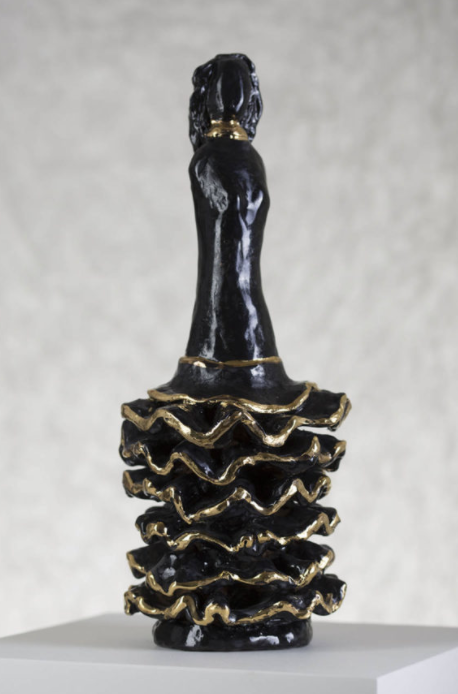
Flamenco Dancer, Earthenware
Ph: Andrea Bianco, Oltre l’apparenza (Beyond appearance) catalogue
Akiko, Fired clay
Ph: Andrea Bianco, Oltre l’apparenza (Beyond appearance) catalogue
8. In 2015 you have designed the first sculpture course for sightless people which currently takes place at the Sacred Art School in Florence. How did you conceive the idea of sharing your artistic knowledge with other sightless people?
I noticed that the accessibility of museums has now become a fundamental point of development. When I proposed to different Italian institutions and schools a tactile program they did not approve it. Fortunately now this has changed and many of them have now integrated it. Although this was a step forward, it was still lacking a course which taught sightless people to become active in the artistic sphere for example through carving, which I think is the form of art that best adapts to these circumstances. I was lucky to have met a German sculptor who taught me to carve for three years. Then I asked myself: what if there were other sightless people that wanted to learn about sculpture and did not have the resources? This was the crucial aim that pushed me to design this course in Florence. By good luck, when I contacted the Sacred Art School they were interested in this project. The first edition had 13 participants and this year we are reproposing it with the aim of delivering a more detailed course that will take three years to complete. This year’s edition starts in September and each year will focus on different topics, for example the first year will be focused on the anatomy of the head and face, the second year on the bust and the last year on the limbs. I tried multiple times to involve institutions, schools and organisations but I always received a negative response. The predisposition for art has less prejudice than us. Any person with any type of disability can find his/her way to express himself/herself in order to feel accomplished. In a normal sculpture course, the sightless person will always be behind. I believe this project is trying to fill this cultural gap by employing unconventional methods that are more suitable for sightless people to gain a type of knowledge that would otherwise be unreachable. In Italy, we lack the presence of an institution that focuses on this issue.
9. How do you choose the colours of your sculptures?
Some people are astonished when they see that many of my sculptures have colours. Of course, I cannot paint the sculptures myself, someone else has to paint them for me. I have visual memory so I remember how each colour looks like. Depending on what I want to express, apart from the shape, I always think about the colour. I believe that a sculpture is completed when shape and colour work well together. In the case of a wooden sculpture, my wife paints it for me in the colour I decide. In the case of ceramic sculptures, it becomes a collaboration between me and the potter who helps me evaluate what colour would fit best with the sculpture I have in mind. The choice of including colour lies in the fact that I have to create artworks for everyone, enjoyable not only for sightless people but also for people with the sense of vision or that have any other type of disability.
10. Many of your sculptures depicting female figures have a specific title: Elvira, Margot, Chantal, Akiko, just to name a few. Is there a meaning behind these particular choices?
I think about the title of a sculpture for a long time, sometimes days or even weeks. I try to make the three elements of shape, colour and title correspond. I came to the conclusion that some sculptures are best left without a title because it often happens that while carving I receive sensations that differ from the ones that a spectator may have read into the artwork. I do not want to dictate what a person should see in my sculptures or impose my vision, I prefer to leave the freedom of interpretation, stimulating imagination, even though sometimes these may be the opposite of my original concept. Art becomes key to access imagination, feelings and memory.
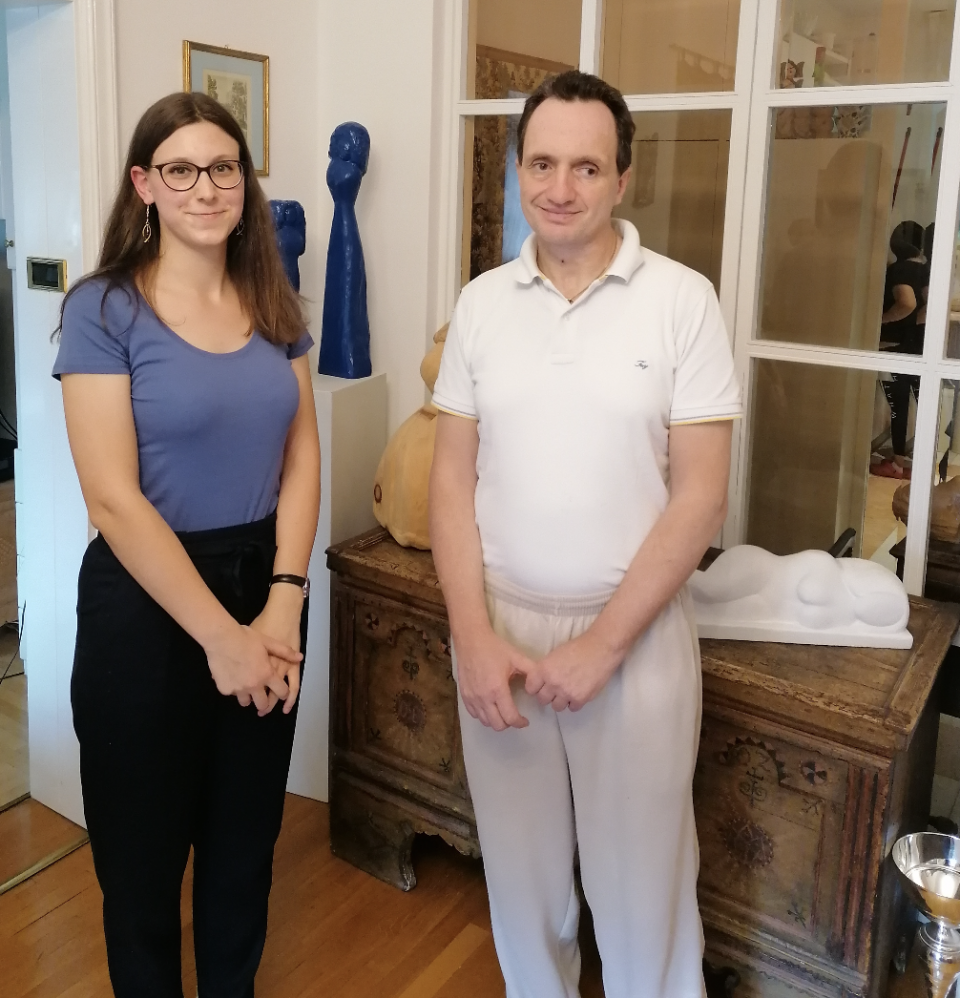
Ph: Belen De Bacco
Discover more on Andrea Bianco’s website: http://www.biancoandrea.com/
Discover more on the sculpture course of the Sacred Art School in Florence: https://sacredartschoolfirenze.com/percorso-artistici-non-vedenti/